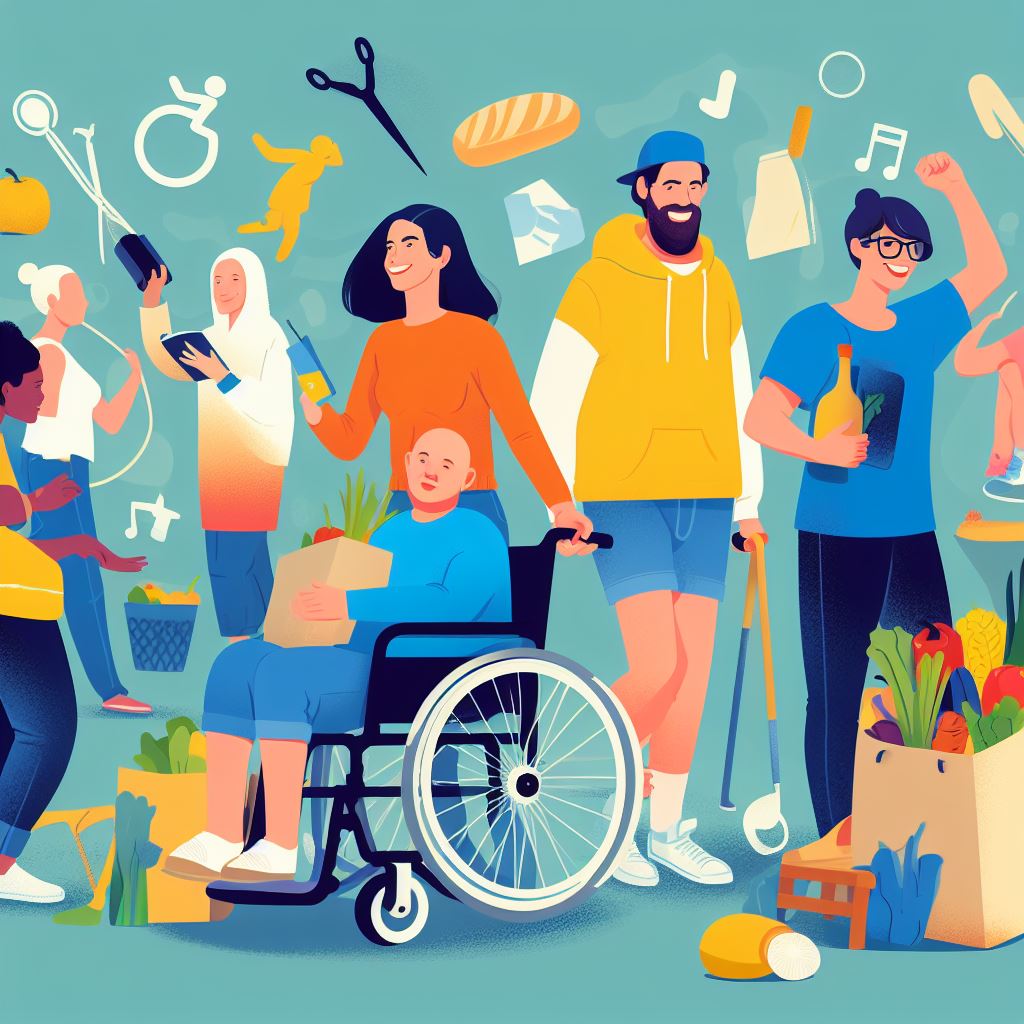What Are SNAP Benefits for Disabled Adults?

Imagine navigating through life with a disability, facing financial challenges along the way.
SNAP benefits could be the helping hand you need. This article dives into the world of SNAP benefits for disabled adults, providing an overview of the program, eligibility requirements, and how to apply.
Discover the array of benefits and services available to you, as well as tips for making the most of your SNAP benefits.
Let’s explore this vital support system together.
Key Takeaways
- SNAP benefits are a federal program that provides nutrition assistance to low-income individuals and families, including disabled adults.
- Disabled adults must meet the general eligibility criteria for SNAP, including income and resource limits, and may qualify automatically if they receive Supplemental Security Income (SSI) benefits.
- Work requirements for SNAP may be waived for disabled individuals.
- SNAP benefits can be used to purchase eligible food items at authorized retailers and are received through an Electronic Benefit Transfer (EBT) card.
SNAP Benefits: An Overview
If you’re a disabled adult, you may be eligible for Supplemental Nutrition Assistance Program (SNAP) benefits. SNAP is a federal program that provides nutrition assistance to low-income individuals and families. It’s designed to help people meet their basic food needs and improve their overall health.
To qualify for SNAP benefits, you must meet certain eligibility criteria, including income and resource limits. The income limit is based on your household size and income level, while the resource limit includes assets such as bank accounts and vehicles. However, certain resources, such as your primary residence and personal belongings, aren’t counted towards the resource limit.
Once you’re approved for SNAP benefits, you’ll receive an Electronic Benefit Transfer (EBT) card, which works like a debit card. You can use this card to purchase eligible food items, such as fruits, vegetables, dairy products, and bread, at authorized retailers, including grocery stores and farmers markets.
It is important to note that SNAP benefits are intended to supplement your food budget, not cover all of your food expenses. Therefore, it’s important to budget wisely and make healthy food choices to stretch your benefits as far as possible.
If you have any questions or need assistance with the application process, you can reach out to your local SNAP office or visit the official SNAP website for more information. Remember, SNAP benefits are here to support you in your journey towards better nutrition and well-being.
Understanding Eligibility for Disabled Adults
To determine if you’re eligible for SNAP benefits as a disabled adult, it’s important to understand the specific criteria that must be met. The eligibility requirements for disabled adults are similar to those for other individuals, but there are a few additional considerations.
First, you must meet the general eligibility criteria for SNAP, which include income and resource limits. However, if you receive Supplemental Security Income (SSI) benefits, you may automatically qualify for SNAP. SSI is a federal program that provides financial assistance to disabled individuals with limited income and resources.
Second, you must meet the disability criteria set by the Social Security Administration (SSA). The SSA considers you disabled if you have a physical or mental impairment that prevents you from engaging in substantial gainful activity and is expected to last for at least 12 months or result in death. You may need to provide medical evidence to support your disability claim.
Lastly, you’ll need to meet the work requirements for SNAP unless you’re exempt due to your disability. Disabled individuals who are unable to work or participate in work-related activities may be exempt from the work requirements.
Understanding these eligibility criteria is crucial in determining if you qualify for SNAP benefits as a disabled adult. If you believe you meet these requirements, it’s recommended to contact your local SNAP office or visit the official SNAP website for further information and assistance.
How to Apply for SNAP Benefits
To apply for SNAP benefits as a disabled adult, you’ll need to gather the necessary documentation and contact your local SNAP office or visit the official SNAP website for the application process.
The first step is to gather all the required documents, which may include proof of identity, income verification, and proof of disability. It’s essential to have these documents ready to expedite the application process.
Once you have your documents in order, you can contact your local SNAP office to schedule an appointment or visit their website for online applications.
During the application process, it’s important to provide accurate and detailed information about your financial situation, living arrangements, and any disabilities or medical conditions that may affect your ability to work or care for yourself. Be prepared to answer questions about your household size, income, and expenses. Remember that the SNAP program is designed to assist individuals and families in need, so providing honest and complete information is crucial.
After submitting your application, it will be reviewed by the SNAP office, and you may be required to provide additional information or documentation. The processing time can vary, but you’ll receive notification of the decision within 30 days.
If approved, you’ll receive an Electronic Benefit Transfer (EBT) card, which works like a debit card and can be used to purchase eligible food items at authorized retailers.
Applying for SNAP benefits can be a daunting process, but it can provide essential assistance to disabled adults in need. Remember to gather your documents, contact your local SNAP office, and be thorough and honest when completing your application.
Benefits and Services Provided by SNAP
Disabled adults who qualify for SNAP benefits receive monthly assistance to help cover the cost of purchasing nutritious food. The Supplemental Nutrition Assistance Program (SNAP) provides eligible individuals with an Electronic Benefit Transfer (EBT) card, which can be used to purchase food items at participating grocery stores, supermarkets, and farmers markets. The benefits are determined based on factors such as income, household size, and expenses. SNAP benefits are intended to supplement a person’s food budget, ensuring that they have access to a balanced diet.
In addition to financial assistance, SNAP also offers several services to support individuals with disabilities. This includes nutrition education programs that provide information on healthy eating habits, meal planning, and budgeting. SNAP participants can also access employment and training services to help them acquire the skills needed to find and maintain employment. Furthermore, some states offer additional benefits for disabled individuals, such as home-delivered meals or assistance with grocery shopping.
These services aim to improve the overall well-being of disabled adults by promoting healthy eating habits, self-sufficiency, and independence. By providing access to nutritious food and supportive resources, SNAP helps disabled individuals lead healthier lives.
Now that you understand the benefits and services provided by SNAP, let’s explore some tips for maximizing your SNAP benefits.
Tips for Maximizing SNAP Benefits
To make the most of your SNAP benefits, follow these tips for maximizing your food assistance.
First, it’s important to understand your eligibility and apply for SNAP if you qualify. The program is designed to help low-income individuals and families, including disabled adults, access nutritious food. Once you’re approved, there are several strategies you can employ to stretch your benefits further.
Plan your meals and make a list before shopping. This will help you buy only what you need and avoid impulse purchases. Look for sales and use coupons to save money. Consider buying generic or store-brand products, as they’re often cheaper but still provide the same nutritional value.
Take advantage of farmers markets and community gardens where you can find fresh, locally grown produce. Many farmers markets accept SNAP benefits, and some even offer incentives to stretch your dollars further. Additionally, consider purchasing frozen fruits and vegetables, as they can be more cost-effective and still retain their nutritional value.
Prepare meals at home instead of eating out. Cooking your own meals allows you to control the ingredients and portion sizes, which can be healthier and more economical. Leftovers can be used for future meals, reducing waste and saving money.
Lastly, it’s important to stay informed about any changes in SNAP policies or benefits. Regularly review your eligibility and report any changes in income or household size to ensure you receive the maximum assistance you’re entitled to.
Frequently Asked Questions
Can Disabled Adults Receive SNAP Benefits if They Are Already Receiving Social Security Disability Insurance (Ssdi) or Supplemental Security Income (Ssi)?
If you are already receiving Social Security Disability Insurance (SSDI) or Supplemental Security Income (SSI), you may be eligible to receive SNAP benefits as a disabled adult.
Are SNAP Benefits Available to Disabled Adults Who Live in Assisted Living Facilities or Nursing Homes?
Living in an assisted living facility or nursing home doesn’t disqualify you from SNAP benefits. As a disabled adult, you can still receive assistance to meet your nutritional needs, even in these settings.
Can Disabled Adults Receive SNAP Benefits if They Have a Caregiver Who Prepares Their Meals?
If you have a caregiver who prepares your meals, you may still be eligible for SNAP benefits as a disabled adult. It is important to meet the program’s criteria and provide necessary documentation.
Are There Any Resources or Programs Available to Help Disabled Adults Navigate the SNAP Application Process?
There are resources and programs available to help you navigate the SNAP application process. These can provide guidance and support as you apply for benefits. Don’t hesitate to reach out for assistance.
Can Disabled Adults Use SNAP Benefits to Purchase Prepared Meals or Restaurant Food?
You can’t zap into a restaurant with SNAP benefits, but you can use them to buy groceries and cook your own meals. Stay healthy and save money by preparing your own delicious dishes.



